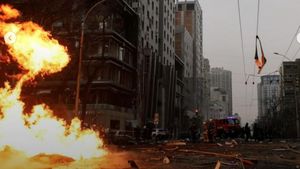From The Trial Of The Tin Commercial Procedure Case, Experts Say There Was A Mistake In Calculating Environmental Losses
JAKARTA - Ecologist and Environmental Losses Calculation Technique, Dr. Dadan Sudana Wijaya,S.E.,M.I.L assessed that there were several fundamental errors in calculating environmental losses based on Ministerial Regulation No. 7 of 2014 which were used in corruption cases worth Rp. 300 trillion.
"I have read the calculation of environmental losses in the indictment based on Permen 7 and I think there have been several mistakes made in the calculation of the loss. For example, related to water problems, the calculation uses a temporary area based on candy 7 which should be based on cubication," said Dadan Sudana in a follow-up hearing in the case of alleged corruption in tin trading system with suspect Thamron Cs at the Jakarta Corruption Court, Thursday (28/11/2024).
In addition, Dadan assessed that related to water management, to determine the compensation rate, the state loss counter used the same quality standard as Permen No 7, namely PHnya 7-9 when in fact the quality standard value in each region was different.
"For example, regarding PH, only 4. The data on the parameter values in Bangka cannot be included," said Dadan.
Dadan also stated that he was not sure that there was environmental damage in the case of alleged corruption in the tin trade system. Because tin mining does not use any chemicals and if there is waste it is only material washing water and rainwater runoff.
Moreover, the Ministry of Environment and Forestry (KLHK) mentioned that the mining proper of PT Timah is in the blue property, which means that it is in the gold category, which means that the state, in this case the Ministry of Environment and Forestry, admits that the processing of lead is not problematic. If it's blue, there are no environmental violations, let alone gold props", he added.Meanwhile, Experts on Damage and Land/Land Remediation, Dr. Ir. Gunawan Djakirana, M.Sc. Agr stated that in calculating environmental losses, an expert needs an expert who not only includes formulas to calculate why if such a high school student can also calculate.
SEE ALSO:
Every ecosystem has different properties so it cannot be generalized. For example, in one place there are tigers, the same parameters cannot be applied in other areas that do not have the meters. In addition, the soil also has its own classification, and the classes depend on conditions," said Gunawan.
For example, to calculate land damage with an area of 70 thousand hectares, is it enough to take just a few samples, it is impossible. Surely the soil type is different and requires accuracy. If you only take a few samples, it means only exploration and if it is done there must be a lot of errors.
When asked about whether there is an obligation within a certain period of time for IUP holders to reclamation, Gunawan stated that as long as the IUP is still valid, the reclamation has not been carried out, it is not a violation.
For example, you can get a permit of hundreds of hectares, but only tens of hectares have been processed. Later, the reclamation can be done last or gradually. Therefore, there is a guarantee of reclamation, the reclamation must be planned and adjusted to its designation in the future," said the Master of Damage and Land/Late Remediation.
Gunawan stated that there are frequent misunderstandings in the public that if a reclamation is carried out, it must return to normal.
It can't be like that, because the government has given permission, it means that there are mining rights and of course some have been damaged. That's why it has to be reclamation, but that doesn't mean the forest must become a forest again, because it could be used as agricultural land or plantation land or water reservoir. So the planning must be seen," he explained.
Whether the reclamation plan can be changed, Gunawan stated that it might be because of several factors. For example, there is a request for the community, reclamation could change. Or for example, it is predicted that there are a million tons of mines, it turns out that the potential is 2 million, so the area of land excavated will also increase, so the IUP holding company may propose to the government regarding the change.
"Reclamation is not rehabilitation, so it is illogical if damaged forests are restored as usual. So there are some local governments who instead ask for land to be rehabilitated and managed as needed," explained Gunawan.
Meanwhile, Forest Management Expert Prof. Dr. Ir. Sudarsono Soedomo, MS, MPPA confirmed that with the granting of a Mining Business License (IUP) by the central and regional governments, it means that the state is fully responsible for the impact of environmental damage that occurs. "The issuance by the state has gone through an analysis of profit and loss. Damage due to mining is the responsibility of the state, while the business entity is only responsible for reclamation," he said. He also highlighted environmental damage due to mining and emphasized that all parties must be careful in calculating the impact of environmental losses caused.
"Calculating the value of these services is not easy. When forest ecosystems are converted into mines, land loss, ecosystem damage due to mining activities must also be taken into account carefully," he said. He also said, calculating environmental losses should use an economic approach, because the term 'loss' has legal consequences in Indonesia. The trick is to compare the initial conditions and the end of the ecosystem, for example in 2018 there will be cassava and rubber gardens with the value of certain ecosystem services, then after changes such as mines, the value of the ecosystem is recalculated, the final value is smaller or bigger, so don't call it a loss.
The English, Chinese, Japanese, Arabic, and French versions are automatically generated by the AI. So there may still be inaccuracies in translating, please always see Indonesian as our main language. (system supported by DigitalSiber.id)

















